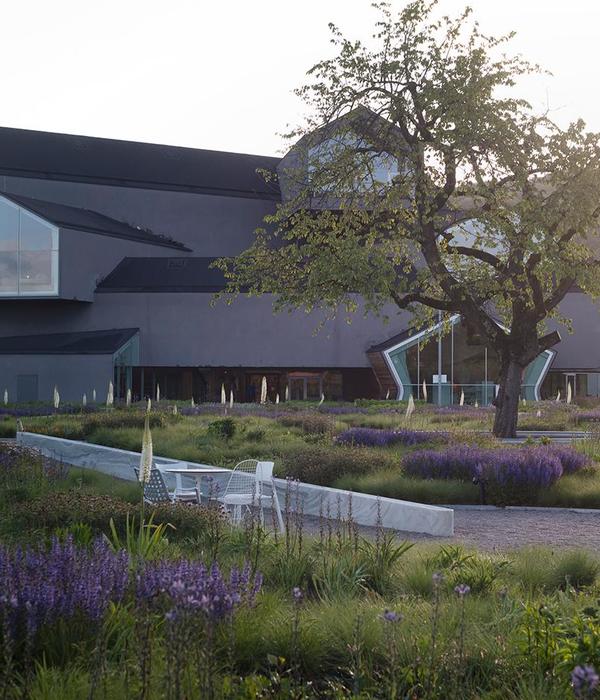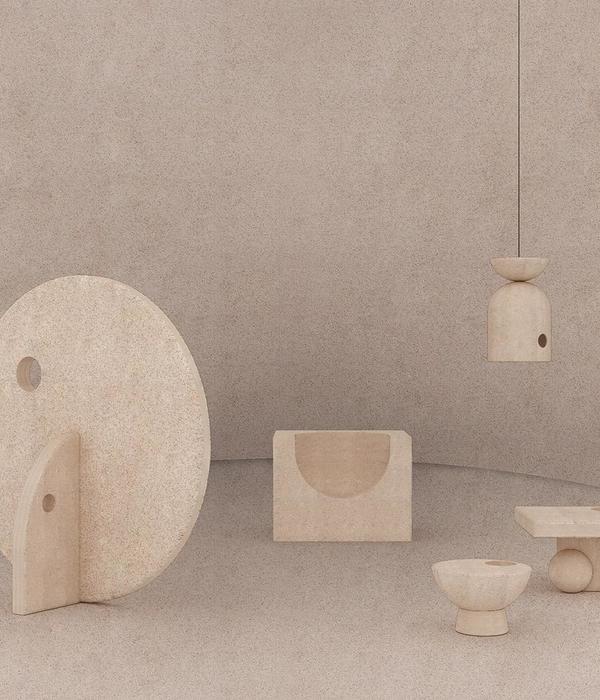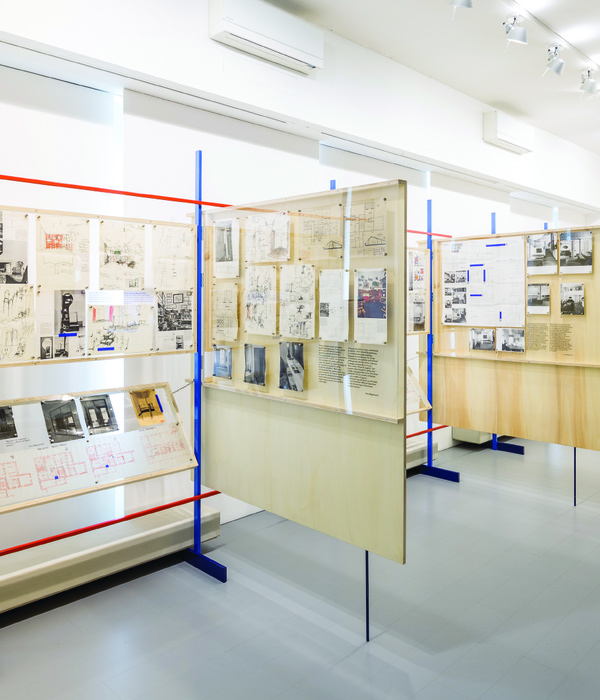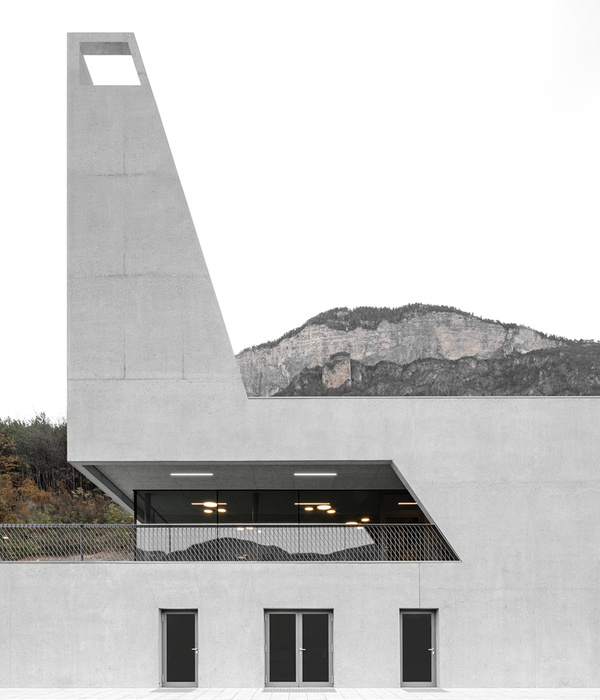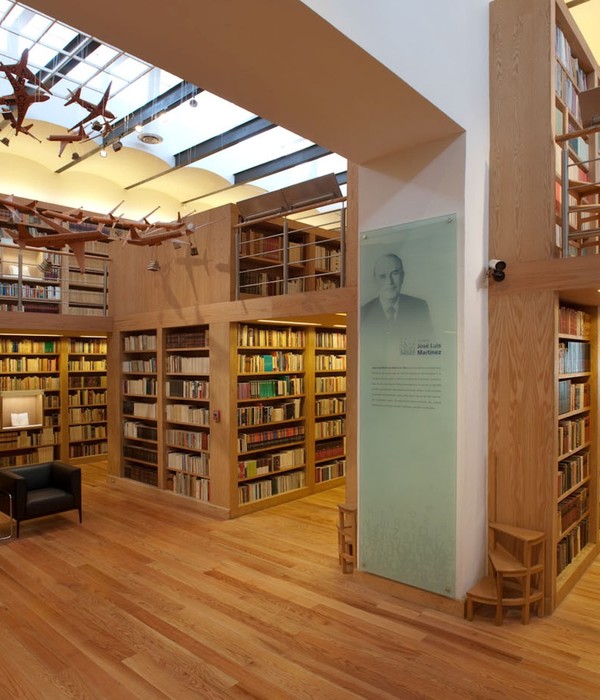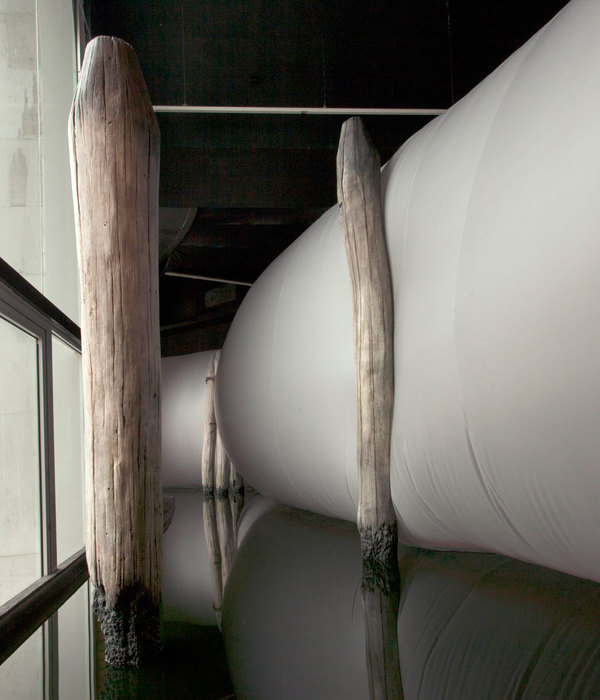在2021年⻄岸艺术与设计博览会上海展中,Alberto Caiola为家具零售商川⾄悦来设计的展位融⼊了再利⽤和再定义的元素,成为博览会上的亮点。他的设计不仅使零售商对可持续发展的承诺得到呈现,还通过创新的形式致敬了该场地的迷⼈历史和要位置,突出了品牌的创造才能。
Incorporating repurposed and reused elements, Alberto Caiola’s booth for furniture retailer Van Collection was a highlight of West Bund Art & Design’s 2021 edition in Shanghai. As well as highlighting the retailer’s commitment to sustainability, the presentation also amplified its creative flair through an innovative tribute to the venue’s fascinating history and important location.
▼展览现场,exhibition © Dirk Weiblen
分隔墙由堆叠的⽔泥袋制成,引导观展者沿着蜿蜒的路径穿过空间。这些分隔障碍设置于不同的⾼度,视也随之时⽽开阔时⽽模糊,创造迷思,吸引⼈们不断⾛进摊位。这些临时凑⽤的材料参考了该场馆的历史功能:⼀座圆顶状的搅拌机,直⾄2009年都位于曾是亚洲最⼤⽔泥⼚的中⼼。
Partition walls made from stacked cement bags guided visitors on a meandering path through the space. Arranged at varying heights, the barriers simultaneously opened and obscured guests’ views to create intrigue and entice fair-goers further into the booth. The make-shift material made reference to the venue’s historical function: a dome-shaped mixer that until 2009, stood at the heart of what was once Asia’s largest cement plant.
▼场地概览,overview of the site © Dirk Weiblen
视中还有诸多⼯业特征。这些都经过刻意保留,以充分利⽤⼯⼚元素和家具设计之间的并列。此外,设计师还拒绝了展会组织者⽤临时墙壁来掩盖这些元素的提议,从⽽⼤⼤减少了展位的浪费⾜迹。
Industrial features were deliberately left in view to take full advantage of the juxtaposition between factory and furniture. Moreover, the decision to decline fair organizers’ offer of temporary walls to conceal these elements significantly reduced the booth’s waste footprint.
▼⽔泥袋制成分隔墙,partition walls made from stacked cement bags © Dirk Weiblen
尽管⽔泥袋只是在展会期间租⽤,但它仍贡献出了⼀座零废弃展台。对于Caiola来说,整个⾏业都应该⿎励复使⽤⽽⾮⼀次性使⽤的设 计,这样的⼲预措施⻚突出了其必要性。“我们⾯临的挑战是找到⼀家愿意与我们合作的建材供应商,”他解释道。“幸运的是,⽔泥不太容 易损坏,即使使⽤过也不会影响其未来的转售。” 随着环境问题在全球议程中占据要地位,在第26届联合国⽓候变化⼤会(COP26) 召开之际,Caiola的设计也为⼯业博览会和贸易展览中采取更可持续的⽅式所作出的及时举措。
Rented only for the days of the design showcase, the cement bags contributed to a zero-waste booth. For the studio, the intervention highlights the need for incentivizing reuse over single use across the industry. “The challenge was to find a building materials supplier willing to work with us,” he explains. “Fortunately cement isn’t really susceptible to getting damaged, and our usage didn’t affect its future resale.” With the environment high on the global agenda, and at an event that coincided with 26th UN Climate Change Conference of the Parties (COP26), our design hopes to mark a move towards a more sustainable approach to industrial fairs and trade shows.
▼保留⼯业特征,industrial features deliberately left © Dirk Weiblen
这个展位巧妙地利⽤了今年早些时候在上海设计展(Design Shanghai)中⾸次亮相的发光的地砖,现已成为川⾄悦来的标志性设计,也突出了其在⽣态友好⽅⾯的资历。这些地砖为此次新建的临时现场做了新配置,呈现了颠覆性的照明理念,不是从家具上⽅,⽽是由家具下⽅向上照亮。由于光源的位置,⽆论是⼈还是产品都不会产⽣影⼦,从⽽带来了友好的感官体验。
In what has now become a signature design feature for Van Collection, and reinforcing its eco-friendly credentials, the booth made smart reuse of illuminated floor tiles debuted earlier this year at Design Shanghai. Reconfigured for their new temporary setting, the tiles overturn expected conventions of display by lighting furniture not from above, but below. The resulting sensory effect is disarming thanks to an absence of shadows cast by either products or people.
▼家具中的视角,view among the furnitures © Dirk Weiblen
Caiola的设计以其简洁的⻛格引⼈注⽬,引导观展者从不同的视⻆思考——有关家具的思考,也有关类似这样的贸易展。他颠覆传统的脚下照明使⼈们成为和物体⼀样的焦点,⽽堆叠出的分隔墙反映出展台的传奇背景,以及在更⼴泛的设计⾏业中的需要关注的环境责任。
Striking in its simplicity, Caiola’s design invited visitors to think differently – both about furniture, as well as trade fairs of this kind. Its atypical underfoot lighting made people as much of a focal point as objects, while its stacked walls offered a reflection on the booth’s storied setting, as well as the environmental responsibilities of the wider design industry.
▼分隔墙反映传奇背景,stacked walls offering a reflection on storied setting © Dirk Weiblen
Alberto Caiola Studio 是⼀家屡获殊荣的⼯作室,专⻔从事室内设计、展览和产品设计,⼯作室启始于2014 年中国上海的 ⼀个⼩型办公室。在所有项⽬中,我们专注⽤户体验以及设计对⽤户所传递的信息,就像艺术⼀样唤起⼈们的内⼼感受以及情感反应。通过对过程与细节的⼀丝不苟,我们将独⼀⽆⼆的理念转化为设计,让设计释放它的真实性与潜⼒。
Alberto Caiola Studio is an award winning practice specialised in interior, exhibition and product design. it was founded in 2014 as a small office in Shanghai, China. We maintain a small, dedicated team while working with an international group of collaborators. In all projects we focus on experiences and how these should touch us, and like art evoke feelings and emotional responses. Through meticulous attention to both process and detail, we translate one-of-a-kind narratives into designs to realise their full authenticity and potential.
▼家具细部,details of the furnitures © Dirk Weiblen
地点:上海 时间:2021 设计:Alberto Caiola 摄影:Dirk Weiblen
Location: Shanghai Date: 2021 Design: Alberto Caiola Photo: Dirk Weiblen
▼项目更多图片
{{item.text_origin}}

